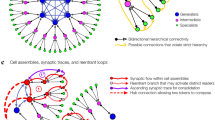Abstract
Traditionally, producing intelligent behaviours for artificial creatures involves modelling their cognitive abilities. This approach raises two problems. On the one hand, defining manually the agent’s knowledge is a heavy and error-prone task that implies the intervention of the animator. On the other hand, the relationship between cognition and intelligence has not been theoretically nor experimentally proven so far. The ecological approaches provide a solution for these problems, by exploring the links between the creature, its body and its environment. Using an artificial life approach, we propose an original model of memory based on the synthesis of several neuroscience theories. The Cortexionist controller integrates cortex-like structure into a connectionist architecture in order to enhance the agent’s adaptation in a dynamic environment, ultimately leading to the emergence of intelligent behaviour. Initial experiments presented in this paper prove the validity of the model.
Similar content being viewed by others
References
Sanchez, S., Balet, O., Luga, H., Duthen, Y.: Autonomous virtual actors. In: 2nd International Conference on Technologies for Interactive Digital Storytelling and Entertainment. LNCS, Darmstadt, Germany, June 2004, pp. 68–78. Springer, Berlin (2004)
Pelachaud, C.: Multimodal expressive embodied conversational agents. In: MULTIMEDIA ’05: Proceedings of the 13th Annual ACM International Conference on Multimedia, New York, NY, USA, 2005, pp. 683–689. ACM, New York (2005)
Turing, A.M.: Computing machinery and intelligence. Mind 59, 433–460 (1950)
Pfeifer, R., Bongard, J.C.: How the Body Shapes the Way We Think: A New View of Intelligence. The MIT Press, Cambridge (2006)
Hawkins, J., Blakeslee, S.: On Intelligence. Times Books, New York (2004)
Lassabe, N., Luga, H., Duthen, Y.: A new step for evolving creatures. In: IEEE-ALife’07, Honolulu, Hawaii, pp. 243–251. IEEE, New York (2007)
Shao, W., Terzopoulos, D.: Autonomous pedestrians. Graph. Models 69(5–6), 246–274 (2007)
Conde, T., Thalmann, D.: An integrated perception for autonomous virtual agents: active and predictive perception: research articles. Comput. Animat. Virtual Worlds 17(3–4), 457–468 (2006)
Funge, J., Tu, X., Terzopoulos, D.: Cognitive modeling: knowledge, reasoning and planning for intelligent characters. In: The 26th Annual Conference on Computer Graphics and Interactive Techniques, pp. 29–38. ACM Press/Addison-Wesley, New York (1999)
Donikian, S.: HPTS: a behaviour modelling language for autonomous agents. In: Proceedings of the Fifth International Conference on Autonomous Agents, Montreal, Canada, 2001
Brooks, R.A.: A robust layered control system for a mobile robot. IEEE J. Robot. Autom., 14–23 (1986)
Minsky, M.: A framework for representing knowledge. Psychol. Comput. Vision, 211–277 (1975)
Kallmann, M., Thalmann, D.: A behavioral interface to simulate agent–object interactions in real-time. In: Proceedings of Computer Animation 99, Geneva, 1999, pp. 138–146. IEEE Computer Society Press, Los Alamitos (1999)
Harnad, S.: The symbol grounding problem. Physica 42, 335–346 (1990)
Panzoli, D., Luga, H., Duthen, Y.: Beyond reactive systems: An associative memory for sensory-driven intelligent behavior. In: Proceedings of the International Conference on CyberWorlds, Bradford, UK, September 2009, pp. 63–70
Frye, J., Ananthanarayanan, R., Modha, D.S.: Towards real-time, mouse-scale cortical simulations. In: CoSyNe: Computational and Systems Neuroscience, 2007
Meyer, J.-A., Guillot, A., Pirim, P., Berthoz, A.: Psikharpax: An autonomous and adaptive artificial rat. In: Proceedings of ISR2004, the 35th International Symposium on Robotics, Paris, 2004
Filliat, D., Meyer, J.-A.: Active perception and map learning for robot navigation. In: From Animals to Animats 6, Proceedings of the Sixth International Conference on Simulation of Adaptive Behavior, pp. 246–255. The MIT Press, Cambridge (2000)
Girard, B., Cuzin, V., Guillot, A., Gurney, K., Prescott, T.J.: A basal ganglia inspired model of action selection evaluated in a robotic survival task. J. Integr. Neurosci. 2(22), 179–200 (2003)
Gibbs, R.W.: A review of ‘how the body shapes the way we think: a new view of intelligence’ from Rolf Pfeifer and Josh Bongard. Pragmat. Cognit. 15(3), 610–614 (2007)
McLean, Paul: The Triune Brain in Evolution. Springer, Berlin (1990)
George, D., Hawkins, J.: A hierarchical Bayesian model of invariant pattern recognition in the visual cortex. In: Proceedings of the International Joint Conference on Neural Networks (IJCNN’05), 2005
Cliff, D., Miller, G.F.: Co-evolution of pursuit and evasion II: simulation methods and results. In: From Animals to Animats 4: Proceedings of the Fourth International Conference on Simulation of Adaptive Behavior, pp. 506–514. The MIT Press, Cambridge (1996)
Terzopoulos, D., Tu, X.: Artificial fishes: physics, locomotion, perception, behavior. In: SIGGRAPH’94 Computer Graphics, ACM SIGGRAPH, pp. 42–48. ACM Press, New York (1994)
Blumberg, B.M., Todd, P.M., Maes, P.: No bad dogs: ethological lessons for learning in Hamsterdam. In: Proceedings of the 4th International Conference on the Simulation of Adaptive Behavior, 1996
Rumelhart, D.E., Hinton, G.E., Williams, R.J.: Learning representations by back-propagating errors. Nature 323, 533–536 (1986)
Anderson, J.R.: The Architecture of Cognition. Harvard University Press, Cambridge (1983)
Arbib, M.A. (ed.): The Handbook of Brain Theory and Neural Networks. The MIT Press, Cambridge (2002)
Hebb, D.: The Organisation of Behavior. Wiley, New York (1949)
Cohen, N.J., Squire, L.R.: Preserved learning and retention of pattern analysing skill in amnesia: dissociation of knowing how and knowing that. Science 210, 207–209 (1980)
Atkinson, R.C., Shiffrin, R.M.: Human memory: a proposed system and its control processes. In: Spence, K.W. (ed.) The Psychology of Learning and Motivation: Advances in Research and Theory, vol. 2, pp. 89–195. Academic Press, New York (1968)
Hall, E.T.: The Hidden Dimension. Anchor Books, Peterborough (1966)
Baddeley, A., Hitch, G.: Working memory. In: Recent Advances in Learning and Motivation, vol. 8. Academic Press, New-York (1974)
Craik, F.I.M., Lockhart, R.S.: Levels of processing: a framework for memory research. J. Verbal Learn. Verbal Behav. 11, 671–684 (1972)
Hochreiter, S., Schmidhuber, J.: Long short-term memory. Neural Comput. 9, 1735–1780 (1997)
Stanley, K.O., Miikkulainen, R.: Evolving neural networks through augmenting topologies. Evol. Comput. 10(2), 99–127 (2002)
Author information
Authors and Affiliations
Corresponding author
Rights and permissions
About this article
Cite this article
Panzoli, D., de Freitas, S., Duthen, Y. et al. The Cortexionist architecture: behavioural intelligence of artificial creatures. Vis Comput 26, 353–366 (2010). https://doi.org/10.1007/s00371-010-0424-3
Published:
Issue Date:
DOI: https://doi.org/10.1007/s00371-010-0424-3




